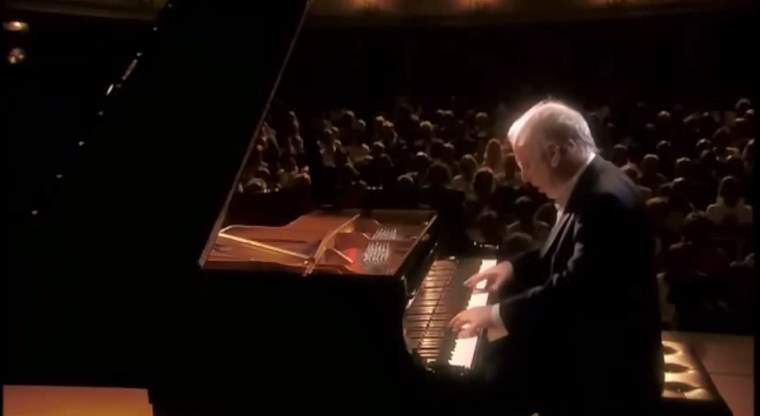Maria João Pires, one of the finest pianists of her generation, performs Ludwig van Beethoven’s Piano Sonata No. 17 in D minor, Op. 31, No. 2, usually referred to as “The Tempest”. Recorded on November 21, 2013, at Salle Pleyel (Paris).
Beethoven: Piano Sonata No. 17 “The Tempest”
Ludwig van Beethoven’s Piano Sonata No. 17 in D minor, Op. 31 No. 2, commonly known as “The Tempest,” is one of his most celebrated compositions. Completed in 1802, during his early middle period, this sonata is a testament to Beethoven’s evolving style and his ability to convey profound emotional depth through music.
“The Tempest” is notable for its dramatic intensity and expressive range. Beethoven composed it at a time when he was grappling with the reality of his increasing deafness, which profoundly influenced his work. The sonata reflects a turbulent inner world, filled with contrasts and sudden shifts in mood.
The nickname “The Tempest” is believed to have originated from a conversation Beethoven had with his associate Anton Schindler. When Schindler inquired about the meaning behind this sonata, Beethoven allegedly suggested that he should read Shakespeare’s play “The Tempest.” While there is no concrete evidence directly linking the sonata to the play, the music’s stormy and unpredictable nature aligns well with the themes of chaos and transformation found in Shakespeare’s work.
One of the most striking features of “The Tempest” is its innovative use of structure and harmony. Beethoven pushes the boundaries of classical sonata form, creating a piece that is both structurally complex and emotionally engaging. The sonata’s opening is particularly notable for its dramatic pauses and sudden changes in dynamics, setting a tone of uncertainty and tension. This unpredictability keeps the listener engaged, as Beethoven seamlessly transitions between moments of lyrical beauty and intense drama.
The harmonic language of the sonata is also remarkable. Beethoven employs bold modulations and dissonances, creating a sense of instability that mirrors the emotional turmoil suggested by the nickname “The Tempest.” This adventurous approach to harmony was ahead of its time and influenced later composers, who admired Beethoven’s ability to blend classical forms with a more expressive and individualistic style.
Movements
“The Tempest” consists of three movements. Each of the movements is in sonata form, though the second lacks a substantial development section.
1. Largo – Allegro
The first movement of Beethoven’s Piano Sonata No. 17 “The Tempest” alternates brief moments of seeming peacefulness with extensive passages of turmoil, after some time expanding into a haunting “storm” in which the peacefulness is lost.
This musical form is unusual among Beethoven’s sonatas to that date. Concerning the time period and style, it was thought of as an odd thing to write; a pianist’s skills were demonstrated in many ways, and showing changes in tone, technique, and speed efficiently many times in one movement was one of them.
The development begins with rolled, long chords, quickly ending with the tremolo theme of the exposition. There is a long recitative section at the beginning of this movement’s recapitulation, again ending with fast and suspenseful passages.
2. Adagio
The second movement in B-flat major is slower and more dignified. It mirrors the opening of the first movement both through the use of a rolling recitative-like arpeggio on the first chord, and the rising melodic ideas in the opening six measures, which are reminiscent of the first movement’s recitative. Other ideas in this movement mirror the first, for instance, a figure in the eighth measure and parallel passages of the second movement are similar to a figure in the sixth measure of the first.
3. Allegretto
The finale of Beethoven’s Piano Sonata No. 17 “The Tempest” is a sonata-rondo hybrid in the key of D minor. It is at first flowing with emotion and then reaching a climax, before moving into an extended development section which mainly focuses on the opening figure of the movement, reaching a climax at measures 169-173.
The recapitulation, which is preceded by an extensive cadenza-like passage of sixteenth notes for the right hand, is followed by another transition and then another statement of the primary theme. The refrain undergoes phrase expansion to build tension for the climax of the movement at measure 381, a fortissimo falling chromatic scale.
Sources
- Piano Sonata No. 17 (Beethoven) on Wikipedia
- OP. 31 NO. 2 “TEMPEST” on the World Of Beethoven website
- Beethoven in His Year of Despair: Piano Sonata No. 17 in D Minor, Op. 31, No. 2, “The Tempest” on the Interlude website
- “Ludwig van Beethoven ‘Piano Sonata No.17’: The Tempest” on the Classicalexburns blog


j’adore cette pianiste !